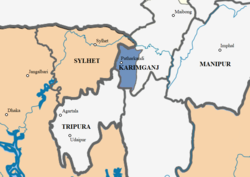Pratapgarh | |
|---|---|
1489–1700s AD
| |
 Present-day Karimganj district (blue) and surrounding areas | |
| Capital | Patharkandi |
| Religion | Islam, Hinduism, Tribal Religions |
| Government | Monarchy |
| Raja Sultan | |
• 1489–1490 | Malik Pratap (first) |
• c. 1700s | Aftab Uddin (last) |
| Historical era | Middle Ages |
• Independence from Tripura | 1489 |
• Kachari conquest | 1700s |
| History of Bengal |
|---|
 |
The Pratapgarh Kingdom (Bengali: প্রতাপগড় রাজ্য) was a medieval state in the north-east of the Indian subcontinent. Composed of the present-day Indian district of Karimganj, as well as parts of Tripura State and Sylhet, Bangladesh, the kingdom was ruled by a line of Muslim monarchs over a mixed population of Hindu and Islamic adherents. It was bordered by the larger kingdoms of Kachar, Tripura and Bengal.
Centred around the hilly, forested region which forms the modern border between eastern Bangladesh and India, the lands which later formed Pratapgarh were initially under the control of the rulers of Tripura and were principally inhabited by Hindu tribes. It is believed that during the latter years of the 15th century AD, the area was seceded by Malik Pratap, a landowner of mixed native and Persian ancestry, who established the kingdom and from whom it may have received its name. Under the rule of his grandson, Sultan Bazid, the influence of Pratapgarh reached its zenith, developing into a significant cultural centre. It also became a notable military power, defeating the stronger kingdom of Kachar as well as engaging against the dominance of Bengal. It was during this time that the state enjoyed its territorial peak, having briefly captured Sylhet from the latter.
Pratapgarh was eventually captured and dissolved by Kachar during the early 18th century, with its ruling family later only governing as Zamindars under the British. However, the kingdom's legacy continued to have a notable impact in the region, with its name being borne by subsequent administrative divisions in the area and its history and legends surviving as oral traditions among the local population.
